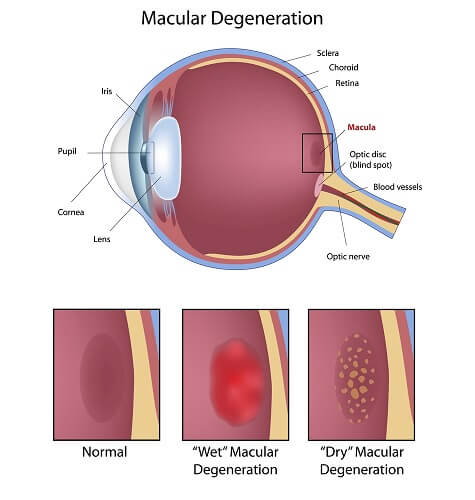Macular Degeneration Diabetes and the Eye
Macular Degeneration
For patients over 65, macular degeneration is the single greatest cause of vision loss and blindness in the U.S. The disease process attacks the retina in a specific location known as the macula, where your sharpest central vision is located. There are two forms of macular degeneration, a dry and a wet form.
In the dry form of macular degeneration, the pigmented cells beneath the retina accumulate waste products, clump together, and lose the ability to support the cells on the surface of the retina. The retina overlying the damaged pigmented cells then dies off.
Patients with mild, or ‘dry’ macular degeneration sometimes describe a fuzzy spot in the center of their vision. In advanced macular degeneration, however, there may be a central blind spot and distortion of the central vision, though peripheral vision typically is unaffected.
Treatment of dry macular degeneration often involves high dose antioxidant vitamins, which have been proven to slow the progression of the dry form to the wet form.

In some cases, small blood vessels can grow in the clumping pigmented cells beneath the retina. These blood vessels are weaker than normal vessels and can easily break or leak fluid resulting in sometimes devastating vision loss.
This is the ‘wet form’ of macular degeneration. Wet macular degeneration may be treated with state-of-the-art photodynamic therapy (PDT) laser or the latest proven medications, Avastin and Lucentis. Avastin and Lucentis work within the eye to specifically target the chemical messengers that create the weak and leaky blood vessels.
By blocking the messengers, the leakage of the damaged vessels is decreased and vision can be increased.
Diabetes and the Eye
Any patient being treated for diabetes by a primary care physician should be seen on a yearly basis for a dilated ocular health exam. Diabetes and fluctuating blood sugars can negatively affect the front and back of your eye, causing prescription changes, cataracts, and retinal disease.
In diabetic eye disease, the normally stable retinal blood vessels develop leaks, allowing fluid or blood to accumulate in the retina. Bleeding or leaking of fluid may cause retinal swelling, keeping the retina from working properly.
Patients describe blurry and distorted vision when fluid begins to leak. This macular edema often responds dramatically to steroid injections, medicines Avastin or Lucentis, or even ‘focal’ laser treatments by our retina specialist. Diabetes can also cause small blood vessels to become obstructed.
The blockage of blood vessels leaves areas of the retina starving for blood, which is carrying oxygen and nutrients. The impaired retina sends out chemical signals to promote new blood vessel growth. These new blood vessels are much weaker than normal vessels and frequently leak or bleed.

At Total Eye Care & Cosmetic Laser Centers, we use the latest in technology to treat all degrees of diabetic retinal disease. Using specialized lasers or medications we can decrease inflammation and fluid accumulation and can decrease or eliminate the new vessel growth.













